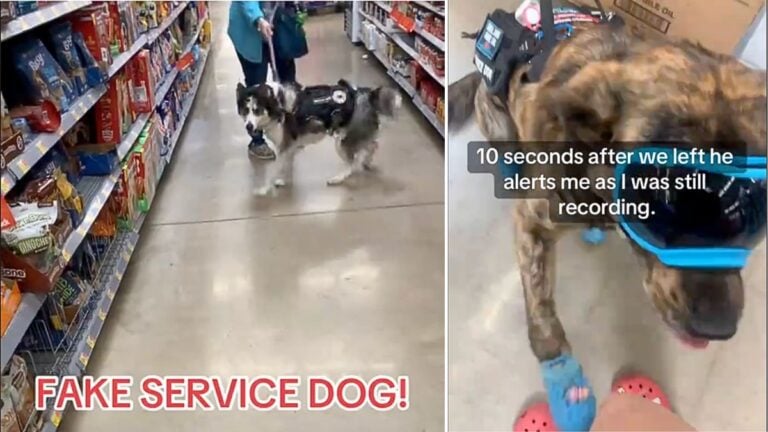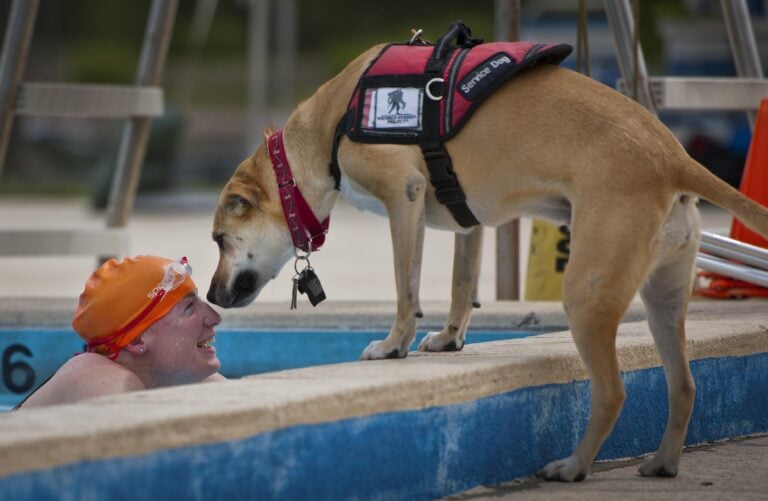Why Viral ‘Fake Service Dog’ Videos Might Be Misleading—Here’s the Truth About New Service Dogs and Emotional Support Animals
Whether you’re walking down the street, shopping at the store, or boarding a plane, there’s a high chance you’ll spot a service dog alongside their handler.

Service dogs seem to be everywhere, and it’s no surprise why: the law allows these dogs to go just about anywhere their owners go. Sadly, there’s an abundance of fake service dogs making their way into public settings. This is mainly because of the privilege that comes with owning a service dog: being able to take your dog anywhere — including places with anti-pet policies — without having to face mandatory identification.
Luckily, it’s not hard to distinguish a real service from a fake one, and it all boils down to the dog’s overall behavior in public.
@k9_apolloo #servicedog #servicedogsoftiktok #servicedogsintraining #fypp ♬ Not My Problem – Laila!
While fake service dogs may bark at people and other pets — a section of netizens, led by TikTok user @meghanelinor, feel that newly trained service dogs, too, can make mistakes in public as they try to get the hang of their jobs.
According to Meghan, people shouldn’t be quick to label every misbehaving pup clad in a service dog vest as fake, since the dog may have just completed training and, therefore, isn’t perfect in their manners yet.
To add to that, Meghan says that some of these legitimate service dogs may be behaving that way because they’re simply trying to do their job. For instance, a psychiatric service dog may seem jumpy in public, but it’s probably because they’re giving their handler deep pressure therapy as they’re trained to.
“Everybody’s disability looks a little bit different. My mom is legally deaf, so she has a hearing dog….her dog just got out of training to be a service dog so it’s still nerve-racking for that animal when they’re going on a plane for the first time,” explained Meghan.
As expected, TikTok users flooded the comment section with varying reactions, with many agreeing with Meghan’s sentiments and others having none of it.
“I am so nervous to travel with my service dog. He is still young and has never been on a plane… I’m afraid strangers would record us and judge us,” wrote user @LatiCher
“Everyone thinks my service dog is jumpy but she actually gives me deep pressure therapy.” commented user @Lydia.
“You also don’t know it isn’t a fake service dog. There must be a license that must be produced for service dogs. So many fakes,” user @Canadaeh stated in disagreement.
Watch the video below:
@meghanelinor #greenscreenvideo thank you for listening to my ted talk… #servicedog #serviceanimal #esadog #emotionalsupportanimal #flying #planes #animal #dogtok #dogs #fy #fyp ♬ original sound – Meghan Elinor
Red Flags 101: How to Catch a Fake Service Dog

Service dogs are a huge blessing to persons living with disabilities. Besides being a source of unmatched companionship and loyalty to their handlers, these specially trained dogs do an exemplary job in meeting their owner’s medical or disability needs.
Typically, service dogs undergo months or even years of rigorous training to be pros at performing these advanced tasks.
Under the Americans with Disabilities Act (ADA), individuals with disabilities aren’t required to present an official service dog certificate to every public space they visit. Unfortunately, many people take advantage of this non-requirement to show up in public spaces with service dogs for their own personal agendas.
In addition to the lenient ADA law, it’s easy to find affordable service dog vests and certificates online. This enables people to obtain fake service dog certification or, rather, fake service dog papers so they can pass off their regular dog as a service animal in places where they need to show proof.
“I think the biggest problem is the federal law itself because ADA law says you don’t have to have a vest, you don’t have to have an ID, you don’t have to have professional training, you can train your own dog. So that makes it very difficult,” experts with K9 Partners for Patriots shared with ABC Action News.
Thankfully, dogs are too talented when it comes to pretending, meaning it won’t take long before a phony service dog’s “mask” falls off in public. So, if you’ve ever wondered, “How to spot a fake service dog,” here are four common telltale signs to look out for:
1. The Dog Isn’t Leashed
Service dog owners are legally required to keep their dogs on a leash or harness when out in public. As much as these amazing pups have undergone service dog training, staying on a leash helps ensure that they stick by their owner’s side at all times to be able to work or perform tasks effectively.
However, there are exceptions. Depending on a person’s disability and the specific task an assistance dog performs, they may not need to be leashed.
A real service dog owner is allowed not to leash their dog if doing so will interfere with the dog’s ability to execute tasks. For instance, a person with a heart condition may need to carry their cardiac service dog in a chest pack so that the dog can feel their handler’s heart rate up close.
And even if a legitimate service dog isn’t leashed, they will not act out of control in public.
So, if you spot a pup wearing a service dog vest but hasn’t been leashed (and seems to be giving their handler a hard time), it’s likely that you’re staring at a fake service dog.
2. People Are Petting the Service Dog
Every legitimate service dog owner knows the drill: No matter how beautiful their dog looks, they can’t let other people pet them because this distraction might make the dog lose focus on their job. So, if you notice a service dog owner allowing any friendly stranger to pet their dog, chances are, their dog is a fake.
3. They’re a Public Nuisance
Generally, trained service dogs are impressively disciplined. You won’t catch them snapping at every stranger or pet they encounter or displaying unwanted potty manners in public.
“A service dog is well-behaved; obedience trained. They don’t go to the bathroom [where they’re not supposed to], they don’t growl, they don’t bark,” expert service dog trainer Mary Peter with the K9 Partners for Patriots revealed.
So, if you spot a service dog acting unruly in public, that’s probably because they’re masquerading as one.
4. Service Dog Being Wheeled Around in Shopping Carts
Service dog owners must adhere to the rule: “all fours on the floor.” This means that under normal circumstances, a service dog should be walking close to their handler.
Of course, this rule doesn’t apply to service dogs who need to be strategically carried around by their handlers so they can perform their tasks effectively.
Therefore, if you notice a service dog enjoying a free shopping cart ride in the supermarket, it’s a sign they aren’t a genuine service dog.
“Owners of real service dogs don’t carry them in shopping carts or purses. The rule is four on the floor with all four feet on the ground except when a dog is performing a task,” Katelynne Steinke of Heroes in Transition (HIT) Canine Co-Pilot Program told PBS News.
What About Emotional Support Dogs?
Emotional Support Dogs (ESDs) are often part of the conversation when it comes to debates about fake service dogs. While ESDs are meant to provide comfort for people with mental health issues like anxiety or depression, they’re not the same as service dogs. Service dogs are specifically trained to perform tasks directly related to a handler’s disability, like guiding someone who is blind or detecting blood sugar drops in a person with diabetes. ESDs, on the other hand, don’t get the rigorous training that service dogs do, which is why they don’t have the same public access rights under the ADA.
The confusion usually starts when people try to pass off their ESDs as service dogs to bring them into places where only service dogs are legally allowed. While ESDs might be great companions, they don’t have the same legal rights and aren’t allowed in public spaces that are restricted to trained service dogs. Unfortunately, this kind of misuse makes it harder for people with real service dogs, creating more skepticism and stricter regulations. So, it’s important to recognize the difference between service dogs, ESDs, and regular pets to avoid contributing to the problem.






